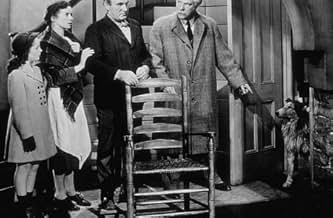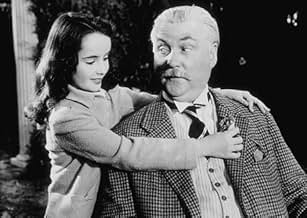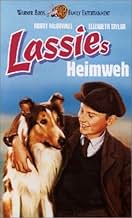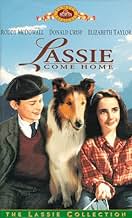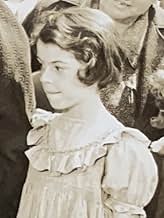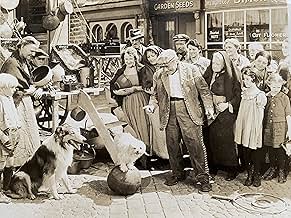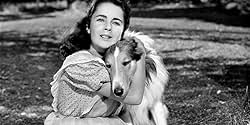After her destitute family is forced to sell her, a collie named Lassie escapes from her new owner and begins the long trek from Scotland to her Yorkshire home.After her destitute family is forced to sell her, a collie named Lassie escapes from her new owner and begins the long trek from Scotland to her Yorkshire home.After her destitute family is forced to sell her, a collie named Lassie escapes from her new owner and begins the long trek from Scotland to her Yorkshire home.
- Nominated for 1 Oscar
- 3 wins & 2 nominations total
May Whitty
- Dally
- (as Dame May Whitty)
J. Pat O'Malley
- Hynes
- (as J. Patrick O'Malley)
May Beatty
- Heavy Woman
- (uncredited)
George Broughton
- Allen
- (uncredited)
Sherlee Collier
- Little Girl
- (uncredited)
Howard Davies
- Cobbler
- (uncredited)
- Director
- Writers
- All cast & crew
- Production, box office & more at IMDbPro
Storyline
Did you know
- TriviaDame Elizabeth Taylor replaced Maria Flynn in the role of Priscilla. Some sources say Flynn was afraid of the dog on the set; others say that she grew taller than Roddy McDowall or that the strong Technicolor lighting caused her eyes to water. In any case, production was halted. Producer Samuel Marx was walking the 600 block of North Foothill Road in Beverly Hills doing his nightly patrol as an air raid warden when he met Francis Taylor, who patrolled the 700 block. Knowing he and Sara Taylor wanted to get their daughter into the movies, he asked him to bring Elizabeth to the studio. There she was introduced to Lassie and the production resumed.
- GoofsWhile speaking about whether to keep Lassie or not it is obvious that the large hearth behind the elderly couple is a drop screen. Shadows from the lights show behind the couple from the viewer's left to right, but the shadows on the hearth shine from the opposite direction.
- Quotes
Joe Carraclough: Ye're my Lassie come home.
- ConnectionsEdited into Hollywood: The Dream Factory (1972)
- SoundtracksAmerica the Beautiful
(1882) (uncredited)
Music by Samuel A. Ward (1882)
Lyrics by Katharine Lee Bates (1895)
In the score during the forward
Featured review
A magnificent British collie struggles to cover the hundreds of miles that separate her from the family she loves.
LASSIE COME HOME is one of the truly great family films. Crafted with care by MGM and based on the classic novel by Eric Knight, it will strike a warm response in the heart of anyone who has ever loved a dog.
The production values are first rate and the color photography is spectacular. While the scenery & filming locations are strictly Western North America, they nevertheless make evocative stand-ins for the settings in the book. It might be worth the viewer's time to check the relationship of the Yorkshire Moors with the Scottish Highlands on a map, so as to better appreciate the phenomenal journey which the dog undertakes.
The casting is excellent throughout: Donald Crisp, Elsa Lanchester & Roddy McDowall as the poor, proud family which must sell their only treasure, Lassie; Nigel Bruce as the gruffly tenderhearted Duke which buys the dog; a young Dame Elizabeth Taylor plays his lively granddaughter. J. Pat O'Malley portrays the brutal dog handler employed by the Duke.
Along her journey Lassie encounters old folks who need her companionship (Dame May Whitty & real-life husband Ben Webster, in his last film role), a traveling tinker who values her protection (Edmund Gwenn), and suspicious sheepmen on the watch for killer dogs (Alan Napier & Arthur Shields).
Lassie is played by Pal, a male dog trained by the celebrated Rudd Weatherwax (1907-1985), who was responsible for generations of Lassies which appeared in movies & television. Pal gives a remarkable performance, providing the very heart & soul of the film.
*************************
Eric Mowbray Knight was born in Yorkshire, England, on April 10, 1897. Moving to America in 1912, he became a student in New York, but left to join the Canadian Armed Forces with the outbreak of World War One. In 1932 he published a collection of his wartime letters - Portrait Of A Flying Yorkshireman. Later came two novels which made good use of authentic Yorkshire dialect: Invitation To Life (1934) and Song On Your Bugles (1937). He didn't think much of his 1940 children's book, Lassie Come-Home and was very surprised at its great success. His next novel, This Above All (1941), a World War Two romance, was also popular. Knight joined the United States Army and rose to the rank of Major. Working with an Army film unit under the direction of Frank Capra, Eric Knight was tragically killed in a plane crash off the coast of Suriname on January 15, 1943. MGM dedicated LASSIE COME HOME, which was released later that year, to his memory.
*************************************
The snatch of ballad Edmund Gwenn is singing while shaving in his first scene is "I Dreamt That I Dwelt In Marble Halls" from the 1843 operetta The Bohemian Girl by Michael William Balfe (1808-1870).
LASSIE COME HOME is one of the truly great family films. Crafted with care by MGM and based on the classic novel by Eric Knight, it will strike a warm response in the heart of anyone who has ever loved a dog.
The production values are first rate and the color photography is spectacular. While the scenery & filming locations are strictly Western North America, they nevertheless make evocative stand-ins for the settings in the book. It might be worth the viewer's time to check the relationship of the Yorkshire Moors with the Scottish Highlands on a map, so as to better appreciate the phenomenal journey which the dog undertakes.
The casting is excellent throughout: Donald Crisp, Elsa Lanchester & Roddy McDowall as the poor, proud family which must sell their only treasure, Lassie; Nigel Bruce as the gruffly tenderhearted Duke which buys the dog; a young Dame Elizabeth Taylor plays his lively granddaughter. J. Pat O'Malley portrays the brutal dog handler employed by the Duke.
Along her journey Lassie encounters old folks who need her companionship (Dame May Whitty & real-life husband Ben Webster, in his last film role), a traveling tinker who values her protection (Edmund Gwenn), and suspicious sheepmen on the watch for killer dogs (Alan Napier & Arthur Shields).
Lassie is played by Pal, a male dog trained by the celebrated Rudd Weatherwax (1907-1985), who was responsible for generations of Lassies which appeared in movies & television. Pal gives a remarkable performance, providing the very heart & soul of the film.
*************************
Eric Mowbray Knight was born in Yorkshire, England, on April 10, 1897. Moving to America in 1912, he became a student in New York, but left to join the Canadian Armed Forces with the outbreak of World War One. In 1932 he published a collection of his wartime letters - Portrait Of A Flying Yorkshireman. Later came two novels which made good use of authentic Yorkshire dialect: Invitation To Life (1934) and Song On Your Bugles (1937). He didn't think much of his 1940 children's book, Lassie Come-Home and was very surprised at its great success. His next novel, This Above All (1941), a World War Two romance, was also popular. Knight joined the United States Army and rose to the rank of Major. Working with an Army film unit under the direction of Frank Capra, Eric Knight was tragically killed in a plane crash off the coast of Suriname on January 15, 1943. MGM dedicated LASSIE COME HOME, which was released later that year, to his memory.
*************************************
The snatch of ballad Edmund Gwenn is singing while shaving in his first scene is "I Dreamt That I Dwelt In Marble Halls" from the 1843 operetta The Bohemian Girl by Michael William Balfe (1808-1870).
- Ron Oliver
- Sep 29, 2002
- Permalink
Details
- Release date
- Country of origin
- Official site
- Language
- Also known as
- Lesi se vraća kući
- Filming locations
- Production company
- See more company credits at IMDbPro
Box office
- Gross worldwide
- $99,248
- Runtime1 hour 29 minutes
- Color
- Aspect ratio
- 1.37 : 1
Contribute to this page
Suggest an edit or add missing content



